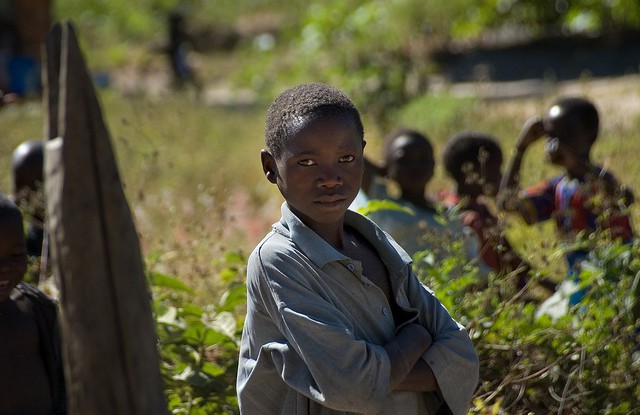
Children living in areas of Africa with heavy tree cover tend to have more nutritious diets, adding credence to research showing that forests play a key role in food security, according to a new paper published in Global Environmental Change.
Boosting production of such energy-rich crops as rice, maize and wheat is often seen as essential to achieving global food security, but if this comes at the expense of forests, this might actually undermine nutritional security.
“Our research shows that children in Africa living in communities surrounded by forest cover have higher dietary diversity and more fruit and vegetable consumption,” said Amy Ickowitz, an economist with the Center for International Forestry Research (CIFOR). “In these areas, dietary diversity increases with tree cover, suggesting that in heavily treed areas, children have healthier diets.”
COMPLEX CHALLENGE
Globally, about 870 million people do not have enough to eat, and more than two billion suffer from micronutrient deficiency, or “hidden hunger,” according to U.N. food agencies, while at least 1.4 billion people are obese or overweight. U.N. data project that the global population will rise from 7 billion to more than 9 billion by 2050, requiring a commensurate increase in food production, which will put more pressure on tropical forests already beset by unsustainable agricultural expansion.
“When the importance of micronutrient consumption and dietary diversity is recognized, the need to move beyond merely increasing production area or yield of staple crops to achieve food security becomes clear,” Ickowitz said. Recent evidence shows that between 1980 and 2000, 95 percent of new land for agriculture came from land that had previously been covered by forests, she noted.
In the study, scientists used regression analysis to determine a statistical association between tree cover and the nutritional quality of children’s diets. They studied dietary data from demographic health surveys of 93,000 children between the ages of 1 and 5 from 21 African countries and combined it with data on tree cover from the Global Land Cover Facility. The regression found a statistically significant positive correlation between tree cover and dietary diversity.
DELICATE BALANCE
The researchers sought to examine the relationship of tree cover to three key indicators of dietary quality connected to micronutrient intake — dietary diversity, consumption of fruits and vegetables, and consumption of animal source foods.
Along the way, the study made an interesting observation: Consumption of fruits and vegetables increased until a peak of 45 percent tree cover, then declined as tree cover increased beyond that, the study found. No similar relationship was found between tree cover and consumption of animal food sources.
We were unable to figure out from our data whether people living near forests are collecting more nutritious foods from the forest, if they are cultivating them on farms and in agro-forests, or a combination
There are three scenarios under which Ickowitz suspected that there might be a positive impact of tree cover on nutrition.
First, the children who live in areas close to forests probably have greater access to wild fruit, leafy greens, grubs, snails and bush meat — foods that can provide such important micronutrients as vitamin A, iron and zinc.
Second, households that plant or harvest agro-forests on their land may benefit from increased access to fruits and nuts from trees.
Third, farming techniques used in more heavily forested areas may result in more nutritious diets because they often involve mixing complex mosaics of multiple crops, Ickowitz said.
“The key underpinning determinant for all three scenarios,” she said, “is that there is a circumstance preventing people in all places from having the same market-mediated access to nutritious foods. For example, they might be unable to afford to buy goods in a local shop because of a lack of cash, or they might be living in a remote location and rely on produce from their local forested area.”
Although the scientists found evidence linking tree cover and indicators of diet quality, their data did not distinguish between natural forests, plantations, old fallows and agroforests.
“We were unable to figure out from our data whether people living near forests are collecting more nutritious foods from the forest, if they are cultivating them on farms and in agro-forests, or a combination,” Ickowitz said.
“The results suggest that deforestation might have a long-term negative effect on nutrition, making it vital that we do further research to better understand the reasons for the association we’ve found between tree cover and nutrition.”
For further information on the topics discussed in this article, please contact Amy Ickowitz at a.ickowitz@cgiar.org
CIFOR’s research on forests and nutrition is part of the CGIAR Program on Forests, Trees and Agroforestry and is supported by the UK Department for International Development (DFID) and The Austrian Development Agency.
We want you to share Forests News content, which is licensed under Creative Commons Attribution-NonCommercial-ShareAlike 4.0 International (CC BY-NC-SA 4.0). This means you are free to redistribute our material for non-commercial purposes. All we ask is that you give Forests News appropriate credit and link to the original Forests News content, indicate if changes were made, and distribute your contributions under the same Creative Commons license. You must notify Forests News if you repost, reprint or reuse our materials by contacting forestsnews@cifor-icraf.org.
